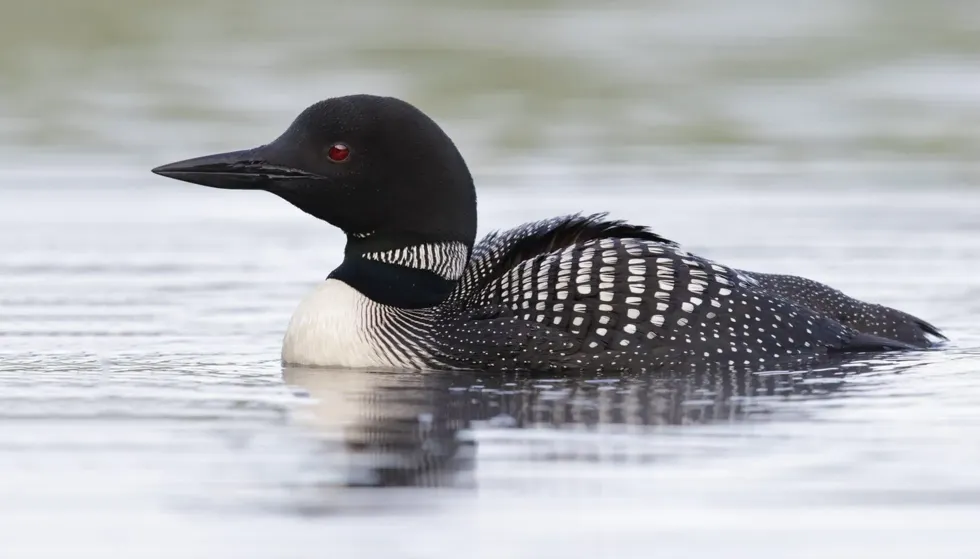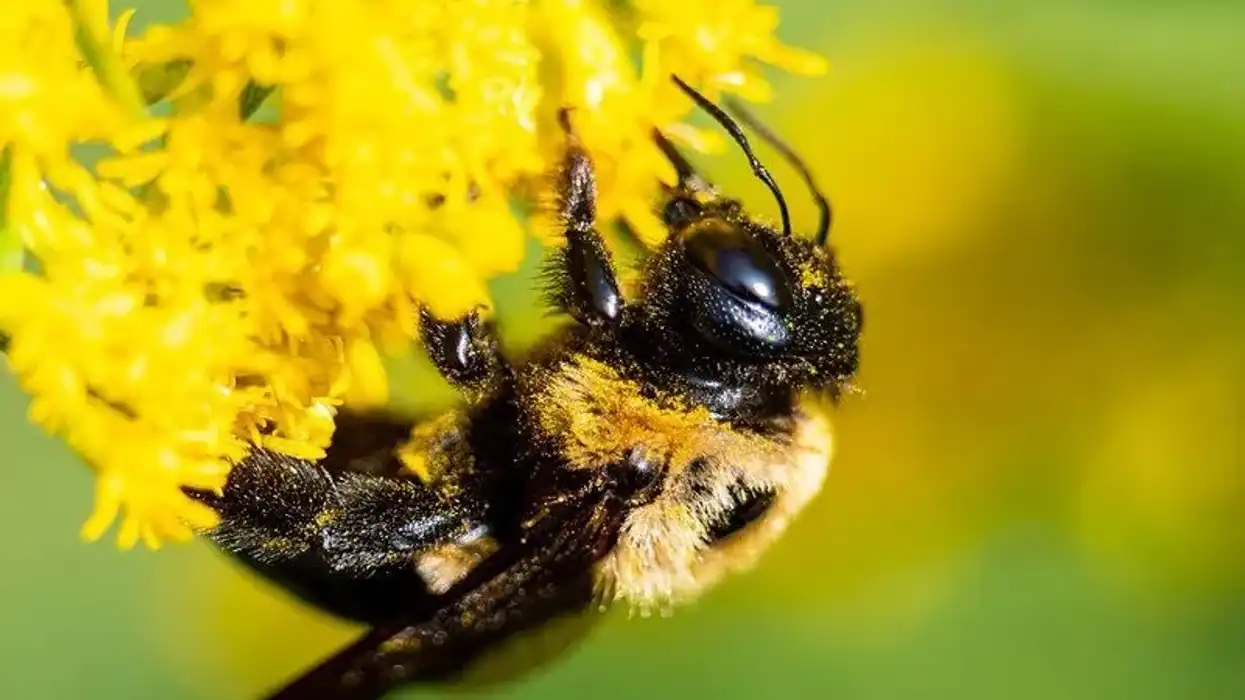The common loon (Gavia immer) is one of the best diver birds to ever exist. Their incredible hunting prowess displayed while diving deep to hunt their prey underwater is a sight to behold which earns them the title of the 'great northern diver'.
Their other name though, the 'common loon' is believed to have originated from their clumsy way of walking on land.
Even though they look like a duck in appearance, scientists have classified them separately from ducks. When it comes to classification, they belong to the order Gaviiformes, family Gaviidae, and genus Gavia.
These species of birds have solid bones, unlike other birds that have hollow bones. These solid bones add to their weight, which in turn helps them with diving.
Their legs are placed towards the back of their body which helps them with swimming in the water, but it also gives them their clumsy walking style.
When it comes to swimming, they can deep dive up to 250 ft (76 m) in the water and can stay underwater for about five minutes. They usually catch small fish or shrimps which they swallow immediately, but they also bring the occasional larger catch up to the surface.
When it comes to the range of these birds, during the spring and summer seasons, common loons prefer to live around the North American and Canadian water bodies surrounded by forests as well as some parts of Greenland. For the common loon, winter marks the time for their migration.
During winter, these North American birds migrate and settle around the north Atlantic and north-east Pacific coastal areas.
Common loons from Canada and Greenland end up around the western European ocean coasts and waters. They also rest at the waters of the Great Lakes of North America during their winter migration.
When it comes to their life history, common loons are monogamous, having a single partner for life unless one of the adults dies, in which case they look for another partner.
Nesting begins in the month of May and nesting sites are found on land spread across the shoreline. After breeding and a successful hatch, the parents return back to the same site the following year.
According to the National Wildlife Federation, common loon populations are stable except for certain states in the U.S. where they are classified as threatened mostly due to human activity and climate changes.
To find out more about the common loon species read on! You can also read our guides to the king penguin and the great green macaw here on Kidadl.
Common Loon Interesting Facts
What type of animal is a common loon?
The common loon is part of the loon group, a type of diver birds that prey on fish.
What class of animal does a common loon belong to?
The common loon belongs to a class of aquatic birds.
How many common loons are there in the world?
The population of common loons is estimated to be between 600,000 to 650,000.
Where does a common loon live?
Depending on the seasons, common loons migrate to different areas. Mostly around the Northern parts of the United States, Canada, Greenland, Iceland, few parts of Europe, and near the North Atlantic and North-East Pacific coasts.
What is a common loon's habitat?
Their habitat differs based on climate and season. During the summer, they migrate to wooded lakes and tundra ponds with an abundant fish population and warm surface waters. During the winter they live near the coastal parts of oceans and lakes, whose waters do not have a lot of ice on the surface.
Who do common loons live with?
Common loons live and eat together and during summers they live together with their partners and chicks.
How long does a common loon live?
They can live for between 15 to 30 years.
How do they reproduce?
Common loons are known to work in families. The parents stick together and breed every year, when the female loon will produce one or two eggs.
They even use the same place, mostly near coastal areas, for nesting, breeding, and hatching their eggs, each year.
They find each other during one of their early summers and they share the responsibility for breeding and hatching the egg together, taking turns sitting on the egg. Once the chicks are hatched and have grown enough to live by themselves, the parents fly away to different locations and return back for breeding at the same nest next summer.
What is their conservation status?
There are large populations of the common loon, with around 600,000 estimated to be in the world. Most of them live in the northern parts of America and their conservation status is Least Concern.
Common Loon Fun Facts
What do common loons look like?
When it comes to the description of the common loon's appearance, they are large birds, much larger than an average duck, with a long body and short tail. Their color changes as per the climate.
During summer, adults have a shiny black head, a medium size bill, and a beautiful black back covered in white dots. During winter, the entire body is covered in gray except for its throat area which is covered in white.
In common loon pictures, an adult can be distinguished by its plumage. One that is ready to breed has a plumage with a black broad head and a shiny green or purple neck, black bill, and red eyes.
The non-breeding ones have a brownish plumage and their eyes are surrounded by white and pale eyelids. Both the male and female loon look the same, except the male is considerably larger than its female counterpart.

How cute are they?
These white dotted birds are quite attractive when compared to other birds, and we think they are very cute! Any description of a common loon is likely to call them cute.
How do they communicate?
The common loon call used for communication is quite popular, and is termed 'the call of the loon'. There different types of calls each having a distinct common loon sound and meaning.
Let's begin with the 'wail', a way for a common loon to communicate with its partner or to signal any nearby threats. A 'hoot' is a short call made between family members or flocks.
A 'yodel' is performed only by a male loon when under stress or at the sight of predators. Finally, a 'tremolo', is also an interaction between loons to report any threats in their territory.
How big is a common loon?
An adult common loon can grow up to 27-36 in (70-90 cm), with an average wingspan of 47 in (120 cm). They can stand up to 79 in (200 cm) tall on average, which makes them roughly twice the size of a full-grown duck.
How fast can a common loon fly?
Common loons have high flying speeds and are known to reach 70 miles per hour (112 km per hour), aiding their migrations every year.
How much does a common loon weigh?
A fully grown common loon can weigh up to 3-17 lb (1.6-8 kg).
What are their male and female names of the species?
Common loons do not have a distinct name for the two genders of the birds. They are simply referred to as male and female common loons.
What would you call a baby common loon?
Baby common loons are called 'chicks'.
What do they eat?
Common loons eat small fish from both freshwater and saltwater, including crayfish and trouts.
Are they dangerous?
Common loons do not pose any dangers to humans except for their spooky calls which may send a chill down our spines if we are not expecting them!
Would they make a good pet?
Common loons do not make a good pet and it is illegal to own a common loon in most regions. Also, their diet means that they have really smelly feces so you wouldn't want one in your home!
Did you know...
Canada's one dollar coin has a bird on it, and it's none other than the common loon. Common loons are popularly known as the 'loonie' in Canada and play an important role in the country's history.
It has been recorded by the U.S. Geological Survey that a loon has traveled more than 1000 km within 24 hours.
If you're looking for Minnesota common loon facts, you will love to know that the common loon is the state bird of Minnesota! These North American birds are found in large numbers in Minnesota. It has the highest population of common loon, second only to Alaska.
Common loons are great on water but are quite awkward on land. This is the result of the species' legs being situated at their rear side with respect to the rest of their body.
Therefore, they need to cover a certain distance by running to begin their flight, and this also forces them to land on water differently, as they slide on their belly instead of using their feet to slow down.
The common loon, of the order Gaviiformes, family Gaviidae, is not considered to be a social bird species. Common loons are found to keep to themselves during most of the day.
Through the night though, they are observed to stick together in flocks while they sleep. When they begin their migration, common loons fly alone, although, just as they sleep in flocks in the night, some common loons like to group together during their migration.
How colorful are they?
Common loons don't have a lot of colors on them except for the white dots all over their shiny black backs. But they also turn gray during the change of seasons, we think this species is a beautiful bird, despite their lack of colorful feathers!
Here at Kidadl, we have carefully created lots of interesting family-friendly animal facts for everyone to discover! Learn more about some other birds including the secretary bird or the scarlet macaw.
You can even occupy yourself at home by drawing one on our Common loon coloring pages.










